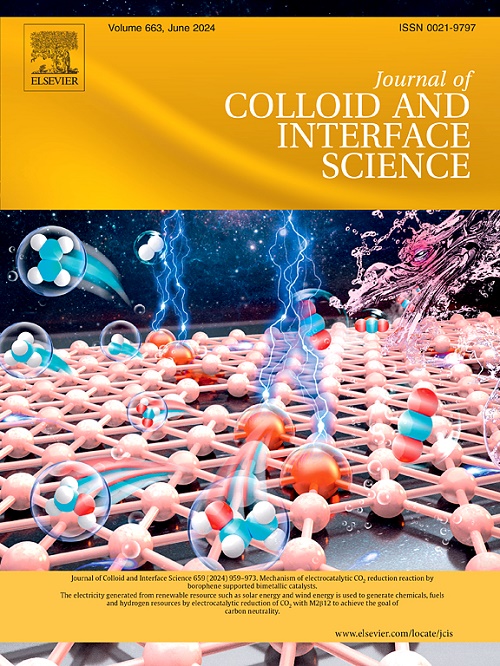混合超级电容器层状微纳结构MoNiCo-S阴极和蚕豆壳碳阳极的制备。
IF 9.4
1区 化学
Q1 CHEMISTRY, PHYSICAL
引用次数: 0
摘要
过渡金属硫化物尽管具有丰富的电化学活性位点,但通常表现出不充分的速率性能和机械稳定性。多维层次结构的发展已被证明是解决与硫化物相关的限制的有效方法。在本研究中,通过“原位生长-蚀刻-硫化”的简单方法,成功合成了具有分层微/纳米结构的MoNiCo-S纳米棒。一维纳米结构CoMoO4作为原位生长ZIF-67的衬底和金属源。随后,路易斯酸被引入以促进氢氧化物的形成,最终通过与硫离子的离子交换合成硫化物。由于其合理的设计和元件组成,MoNiCo-S具有优异的电容性能(在1 A/g时为3125.1 F/g)和循环稳定性(5000次循环后电容保持率为72.9%)。此外,通过炭化活化工艺制备的蚕豆壳衍生碳(KBBC)的比电容为295.0 F/g,循环电容保持率为99.6%。组装的MoNiCo-S//KBBC非对称超级电容器器件在1004.3 W kg-1的功率密度下实现了78.5 Wh kg-1的高能量密度。经过10,000次循环后,该器件的电容保持率为107.9%,显示出良好的循环稳定性。该研究对硫化物材料在性能优化设计方面的进步具有重要意义。本文章由计算机程序翻译,如有差异,请以英文原文为准。

Construction of layered micro-/nano-structured MoNiCo-S cathode and broad bean shell derived carbon anode for hybrid supercapacitors
Transition metal sulfides, despite their abundance of electrochemically active sites, often demonstrate inadequate rate performance and mechanical stability. The development of a multi-dimensional hierarchical architecture has proven to be an effective approach to address the limitations associated with sulfides. In the present study, MoNiCo-S nanorods featuring hierarchical micro-/nano-structures were successfully synthesized through a straightforward methodology that involved “in situ growth-etching-vulcanization”. The one-dimensional nanostructure CoMoO4 served as both the substrate and metal source for the in-situ growth of ZIF-67. Subsequently, Lewis acid was introduced to facilitate the formation of hydroxides, ultimately leading to the synthesis of sulfides via ion exchange with sulfur ions. Due to its rational design and element composition, MoNiCo-S exhibited excellent capacitance (3125.1 F/g at 1 A/g) and cycling stability (capacitance retention rate of 72.9 % over 5,000 cycles). In addition, the broad bean shell derived carbon (KBBC), prepared through a carbonization and activation process, demonstrated a specific capacitance of 295.0 F/g and a cyclic capacitance retention of 99.6 %. The assembled MoNiCo-S//KBBC asymmetric supercapacitor devices achieves a high energy density of 78.5 Wh kg−1 at a power density of 1004.3 W kg−1. After 10,000 cycles, the device exhibited a capacitance retention rate of 107.9 %, indicating excellent cycling stability. This research contributes significantly to the advancement of sulfide materials in the context of performance optimization design.
求助全文
通过发布文献求助,成功后即可免费获取论文全文。
去求助
来源期刊
CiteScore
16.10
自引率
7.10%
发文量
2568
审稿时长
2 months
期刊介绍:
The Journal of Colloid and Interface Science publishes original research findings on the fundamental principles of colloid and interface science, as well as innovative applications in various fields. The criteria for publication include impact, quality, novelty, and originality.
Emphasis:
The journal emphasizes fundamental scientific innovation within the following categories:
A.Colloidal Materials and Nanomaterials
B.Soft Colloidal and Self-Assembly Systems
C.Adsorption, Catalysis, and Electrochemistry
D.Interfacial Processes, Capillarity, and Wetting
E.Biomaterials and Nanomedicine
F.Energy Conversion and Storage, and Environmental Technologies

 求助内容:
求助内容: 应助结果提醒方式:
应助结果提醒方式:


